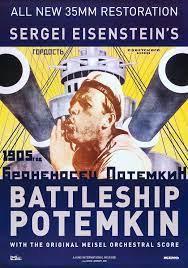
In 1905 the battleship Potemkin is returning from the Russo-Japanese war to its home port of Odessa on the Black Sea. The sailors have endured many hardships, especially from the officers. When the meat they are served is full of maggots the crew complains. The loudest of these complainers is Grigory Vakulinchuk (Aleksandr Antonov). The men are served soup made from the rotting meat. Some of the sailors refuse to eat it.
The next day Captain Golikov (Vladimir Barsky) lines up the sailors that refused to eat the soup. He then assembles a firing squad and orders that the sailors be shot. Vakulinchuk rouses the crew’s anger and they mutiny. The Captain and his officers are thrown overboard. During the fight Vakulinchuk is killed.
When the Potemkin gets to Odessa the crew brings Vakulinchuk ashore and set up a makeshift memorial around him. The citizens of Odessa become appalled by his death and support the sailors. They provide the men food. Their riotous behavior attracts the police who open fire on the people on the steps of Odessa.
The Potemkin puts to sea to avoid the Cossacks. They turn the ship’s guns on the soldiers and the buildings owned by the Tsar. The Tsar sends his warships to intercept the Potemkin and stop the rebellion.
“Battleship Potemkin” AKA “Bronenosets Potemkin” was released in 1925 and was directed by Sergei Eisenstein. It is a Soviet silent film and propaganda. The film is broadly based on actual historical events that occurred after the war with Japan. The film was commissioned by Lenin to commemorate the twentieth anniversary of the event. The aim was to bolster the Russian revolution and overthrow Tsar Nicholas II.
Director/writer Eisenstein separated the film into five acts, Act I: Men and Maggots, Act II: Drama on Deck, Act III: A Dead Man Calls Out, Act IV: The Odessa Steps and Act V: One Against All.
For a film from 1925, it is very graphic. The massacre on the steps of Odessa is violent and bloody. Close-ups of women and children being mowed down by Cossack soldiers are stunning, even in silence. The film holds nothing back when it comes to carnage. It is the most poignant sequence of the film and was made up. There was no massacre on the Odessa steps. The scene is actually a representation of the riots that were taking place all over Russia.
The film was banned in several countries for fear that it would spread communism. It ran for a while in France before it was banned in 1925. The ban was lifted in 1953 after the death of Russian leader Joseph Stalin. The UK banned the film in 1926. The ban was finally lifted in 1954 when it was given an X rating. For a time the film was also banned in the Soviet Union and the United States. Many countries banned it for a while and lots of cuts were made in others. Some banned it for its violence and some for fear that it would promote political zeal, some for both reasons.
The battleship used during the filming was the "Dvenadstat Apostolov" or “The Twelve Apostles”.

